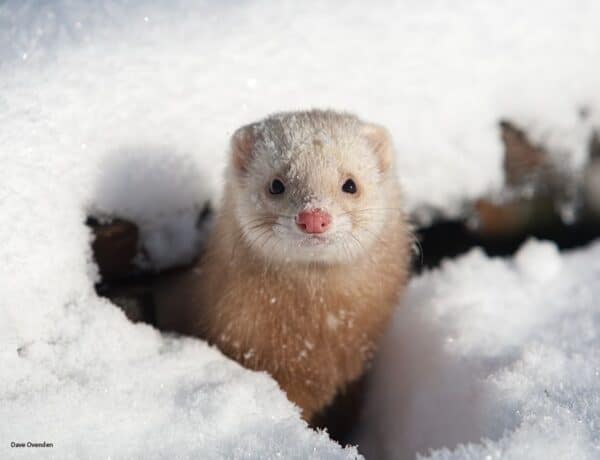Introduction
How Fast Can A Ferret Run: Ferrets, those sleek and playful members of the weasel family, have long captivated the hearts of pet owners and animal enthusiasts alike. We will delve into the remarkable agility and speed of ferrets, shedding light on their impressive running abilities.
Ferrets, Mustela putorius furo, are small carnivorous mammals that have been domesticated for thousands of years. In their wild ancestors, agility and speed were essential traits for hunting and evading predators. While domestication has changed some aspects of their behavior, ferrets have retained their natural athleticism. They are built for quick movements with a slender body, long neck, and sharp claws, which provide them with excellent balance and grip on various surfaces.
When it comes to speed, cold ferrets can surprise many with their rapid sprints. On average, a healthy adult ferret can achieve speeds of 10 to 15 miles per hour (16 to 24 kilometers per hour). While this might not rival the speed of some larger mammals, it’s quite impressive considering their small size. This speed allows them to chase after toys, explore their surroundings, and engage in playful games of tag with their human companions.

How Fast Can A Ferret Move?
Ferrets live 7-10 years with an average lifespan of 8 years. How fast is a Ferret? A Ferret can travel at speeds of up to 15 miles per hour.
Ferrets, those curious and sprightly members of the weasel family, are known for their agility and quick movements. If you’ve ever observed a ferret in action, you’ve likely wondered just how fast these pint-sized predators can really move. We will uncover the impressive speed and nimbleness that ferrets exhibit in their everyday activities.
Ferrets, scientifically known as Mustela putorius furo, possess a body built for speed. Their sleek, elongated form, flexible spine, and powerful leg muscles are all adaptations honed over thousands of years of evolution. These characteristics enable ferrets to excel in activities that require bursts of speed and agility.
On average, a healthy adult ferret can reach speeds of 10 to 15 miles per hour (16 to 24 kilometers per hour) during a sprint. While this may not rival the speeds of cheetahs or gazelles, it’s quite remarkable when you consider their diminutive size. This speed allows them to zip around their environment with ease, darting through tunnels, racing after toys, or even engaging in playful chases with their human companions.
What truly sets ferrets apart, however, is their ability to change direction with astonishing agility. Ferrets are known for their sharp turns, rapid pivots, and quick shifts in momentum. This makes them incredibly elusive and effective hunters, both in the wild and during playtime.
How Smart Is A Ferret?
Ability to Problem Solve: ferrets rank above dogs and cats and some small primates. The weasel family is famously known for their ability to figure out how to get into just about anything. Any ferret owner will tell you: If a ferret wants to get somewhere bad enough, they will figure it out.
Ferrets, members of the weasel family, are renowned for their playful antics and curious behavior. We will delve into the intelligence of ferrets, exploring their problem-solving abilities, social intelligence, and capacity for learning.
Ferrets are intelligent animals that exhibit a range of complex behaviors indicating cognitive capabilities. They possess problem-solving skills, which they often employ to navigate their environment and find solutions to obstacles. Whether it’s figuring out how to open a latch on a cage or finding a hidden toy, ferrets demonstrate a level of problem-solving intelligence that is both fascinating and impressive.
Social intelligence is another hallmark of a ferret’s intellect. They are highly social animals that thrive on interaction with both their fellow ferrets and human companions. Ferrets can recognize familiar faces, respond to their names, and even learn various commands with consistent training. They form strong bonds with their owners, demonstrating emotional intelligence and the ability to understand and reciprocate affection.
Ferrets also display a keen sense of curiosity and exploration. They enjoy investigating new environments, objects, and scents, which indicates an inquisitive nature and a desire to learn about their surroundings. This curiosity drives their playfulness and their interactions with toys and enrichment activities.
Do Ferrets Like To Run Away?
Rather than curiosity, ferrets who run from their owners when outside are simply trying to fulfil their first priority: Safety. Most ferrets run away when released outdoors because they are simply afraid. They are trying to protect themselves.
Ferrets, those mischievous and inquisitive members of the weasel family, are known for their love of exploration and play. While they might not have a particular preference for running away, their natural curiosity and boundless energy can lead them to wander off if not properly supervised. We will explore the reasons why ferrets may seem inclined to “run away” and how to ensure their safety and well-being.
Ferrets are born with an innate curiosity that drives their need to investigate their surroundings. They have a strong instinct to explore, dig, and tunnel, which can sometimes lead them to venture into spaces where they shouldn’t. Their natural inclination to squeeze into tight spaces or investigate hidden corners can make it appear as if they are running away when, in fact, they are merely satisfying their insatiable curiosity.
In a home environment, ferrets will often engage in games of hide-and-seek, darting under furniture or into closets, drawers, or laundry piles. They do this not because they want to escape but because they find it stimulating and entertaining. To create a safe and enriched environment that allows these playful creatures to indulge their curiosity while minimizing the risk of escape or injury.
Are Ferrets Calm Pets?
Ferrets make good pets if you want to maintain peace and quiet in your household. Although known for their high energy, ferrets are very quiet too and sleep for about 18 hours per day! They are not nocturnal, but sleep the majority of the day just like cats do.
Ferrets, with their playful and curious nature, may not immediately strike one as calm pets. However, their temperament can vary widely depending on factors such as age, socialization, and individual personality. In this discussion, we’ll explore whether ferrets can be considered calm pets and what owners can do to ensure a harmonious and relaxed coexistence with these delightful creatures.
Ferrets are naturally active and inquisitive animals. They have boundless energy and love to explore their surroundings, often engaging in playful antics that may appear quite lively and even hyperactive. This exuberance is especially pronounced in young ferrets, known as kits, who tend to be more rambunctious.
While ferrets are not typically described as “calm” in the sense that some other pets, like cats or tortoises, are, they can display moments of calmness and affection. As ferrets age, they often mellow out and become more relaxed compared to their younger counterparts. Older ferrets tend to enjoy cuddling and lounging with their owners, making them appear calmer and more content.
Can Ferrets Cry?
It is not so much what the ferret does as it is a change in behavior. In other words, while ferrets stoically won’t show pain or distress by crying, they often signal pain with behavioral changes.
Ferrets, like many animals, do not cry tears in the way humans do to express emotions such as sadness. They lack the tear ducts and the physiological mechanism necessary for producing emotional tears. However, they can display behaviors and vocalizations that may seem like crying to their owners, and these behaviors often have specific reasons behind them.
Whimpering and Whining:
Ferrets can emit high-pitched vocalizations, such as whimpers and whines, when they are distressed, frightened, or in pain. These sounds might be mistaken for crying, especially by those unfamiliar with ferret behavior. It’s essential for ferret owners to pay attention to these vocal cues as they can indicate that something is wrong and requires attention.
Hissing and Squealing:
During aggressive or territorial encounters with other ferrets or animals, ferrets may hiss, squeal, or screech. These vocalizations can be loud and intense, but they are not expressions of sadness or emotional distress. Instead, they are forms of communication related to dominance or defending territory.
Playful Chirping:
Ferrets can make cheerful, chirping sounds when they are excited or engaged in play. This vocalization, often referred to as “dooking,” is a sign of their enthusiasm and is quite different from crying. It’s a positive expression of their happiness and playfulness.
Sudden Changes in Behavior:
When ferrets experience significant stress or fear, they might exhibit behaviors like hiding, trembling, or becoming less active. These changes in behavior can be indicative of emotional distress or discomfort, even though they don’t cry tears.
Can I Let My Ferret Run Outside?
Yes you can. Ferrets love playing outside in the snow, and enjoying tunneling and chasing one another. Playing provides excellent environmental and mental stimulation for them. You should make sure you keep your ferrets on a leash and harness if they’re playing outside, to prevent them from escaping.
Allowing your ferret to roam freely outside can be a tempting idea, as these curious creatures enjoy exploration. However, there are several important considerations and potential risks to keep in mind when deciding whether to let your ferret run outside.
Safety Concerns
Predators: Ferrets are small animals and are vulnerable to predators such as birds of prey, foxes, and larger mammals. Allowing them to roam unsupervised can put them at risk of being attacked.
Traffic: Ferrets are not aware of the dangers posed by vehicles. If they wander onto the road, they can be easily injured or killed by passing cars.
Escape: Ferrets are skilled escape artists. Their small size allows them to slip through tiny openings or dig under fences, making it challenging to keep them contained in an outdoor area.
Health Risks
Parasites: The outdoors can expose ferrets to various parasites like fleas, ticks, and mites. These can lead to health issues and discomfort for your pet.
Disease Transmission: Wild animals can carry diseases that can be transmitted to your ferret. This includes illnesses like rabies, which poses a serious risk to both your pet and yourself.
Environmental Hazards
Poisonous Plants: Ferrets may chew on plants while exploring. Some outdoor plants can be toxic to ferrets if ingested.
Chemicals: Pesticides, fertilizers, and other chemicals used in gardens and lawns can be harmful if ingested or if they come into contact with your ferret’s fur and skin.
Supervised Play: If you decide to let your ferret play outside, it should always be done under strict supervision. Use a secure enclosure, like a ferret playpen or harness and leash, to ensure your ferret cannot escape and is protected from predators.
Alternative Indoor Play
Ferrets can enjoy plenty of safe play and exploration indoors. Create a ferret-friendly environment with tunnels, toys, and spaces for them to explore. This not only keeps them safe but also prevents potential harm to local wildlife.
Will Ferrets Try To Run Away?
With their inquisitive and adventurous nature, ferrets can easily go astray whenever they start exploring the world around them.
Ferrets have a reputation for being curious and adventurous animals, which can sometimes lead to the perception that they will try to run away. While ferrets are naturally curious and may explore their surroundings with enthusiasm, their behavior regarding running away is influenced by various factors.
Curiosity
Ferrets are innately curious creatures. They have a strong desire to investigate their environment, which often includes small, hidden spaces and tight corners. This exploratory nature can give the impression that they are trying to escape when, in reality, they are just satisfying their natural inquisitiveness.
Playful Behavior
Ferrets are playful animals that enjoy games of hide-and-seek and chase. They may dart under furniture, into closets, or behind objects during playtime. This playful behavior is not an attempt to run away but rather a way to engage in interactive games.
Secure Living Space
Providing a secure and ferret-proofed living environment is crucial to prevent actual escape attempts. Ferret owners should take measures to block off escape routes, secure cabinets and drawers, and seal small openings or holes to ensure that their pets cannot run away accidentally.
Bond with Owners
Ferrets often form strong bonds with their human companions. They may seek out their owners for attention, cuddles, and play. This bond can reduce the likelihood of ferrets attempting to escape because they enjoy their interactions with their owners.
Supervision
When ferrets are allowed to play outside of their enclosure or designated play area, supervision is essential. Even with a secure space, they may still try to explore beyond the boundaries. Proper supervision ensures their safety and prevents escape attempts.
Training and Socialization
Ferrets can be trained to respond to commands and become accustomed to human interaction. Adequate socialization and training can help reduce their curiosity-driven exploration and make them more obedient during playtime.
How Fast Does A Ferret Run?
How fast is a Ferret? A Ferret can travel at speeds of up to 15 miles per hour.
Ferrets, those small and sprightly members of the weasel family, are known for their agility and speed. While they may not break any land-speed records, ferrets are surprisingly swift for their size. In this discussion, we will explore how fast a ferret can run and the factors that influence their speed.
On average, a healthy adult ferret can reach speeds of 10 to 15 miles per hour (16 to 24 kilometers per hour) during a sprint. Keep in mind that this speed range can vary among individual ferrets. Factors like age, overall health, and conditioning play a role in determining how fast a ferret can run.
Young ferrets, known as kits, tend to be more energetic and agile, often displaying faster sprints than older ferrets. As ferrets age, their speed may gradually decrease, but they can still maintain a respectable pace well into their adult years.
Regular exercise and play are essential to maintaining a ferret’s agility and speed. Ferrets are highly active animals and need opportunities to run, jump, and play to keep their muscles toned and their energy levels in check. Providing them with toys, tunnels, and interactive playtime can help keep them in good shape both physically and mentally.
Ferrets are naturally built for quick movements. Their slender bodies, long necks, and sharp claws give them excellent balance and grip. This physical adaptation allows them to navigate various surfaces, including carpets, hardwood floors, and even vertical climbs.

Conclusion
Ferrets are small but incredibly agile and speedy creatures. While they may not compete with the fastest land animals, their natural athleticism and curiosity make them surprisingly swift for their size. On average, a healthy adult ferret can reach speeds of 10 to 15 miles per hour during a sprint. Ferrets may vary in their speed due to factors like age, health, and conditioning.
Ferrets’ speed is a result of their physical adaptations, including their slender bodies, long necks, and sharp claws, which provide them with excellent balance and grip. This allows them to navigate various surfaces with ease, from carpets to hardwood floors, and even to climb vertically when the mood strikes.
Beyond their straight-line speed ferrets are known for their agility. They can make sharp turns and quick changes in direction, which is not only impressive but also essential for their playful and exploratory nature. Whether they are chasing Ferrets toys, engaging in games with their human companions, or simply exploring their environment, their agility adds a layer of fascination to their behavior.





No Comments